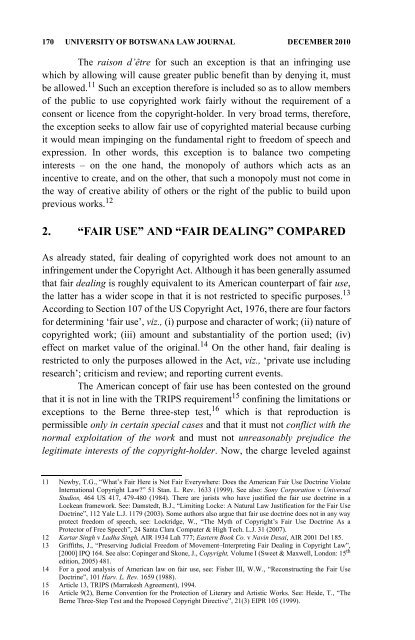University of Botswana Law Journal - PULP
University of Botswana Law Journal - PULP
University of Botswana Law Journal - PULP
You also want an ePaper? Increase the reach of your titles
YUMPU automatically turns print PDFs into web optimized ePapers that Google loves.
170 UNIVERSITY OF BOTSWANA LAW JOURNAL DECEMBER 2010<br />
The raison d’être for such an exception is that an infringing use<br />
which by allowing will cause greater public benefit than by denying it, must<br />
be allowed. 11 Such an exception therefore is included so as to allow members<br />
<strong>of</strong> the public to use copyrighted work fairly without the requirement <strong>of</strong> a<br />
consent or licence from the copyright-holder. In very broad terms, therefore,<br />
the exception seeks to allow fair use <strong>of</strong> copyrighted material because curbing<br />
it would mean impinging on the fundamental right to freedom <strong>of</strong> speech and<br />
expression. In other words, this exception is to balance two competing<br />
interests – on the one hand, the monopoly <strong>of</strong> authors which acts as an<br />
incentive to create, and on the other, that such a monopoly must not come in<br />
the way <strong>of</strong> creative ability <strong>of</strong> others or the right <strong>of</strong> the public to build upon<br />
previous works. 12<br />
2. “FAIR USE” AND “FAIR DEALING” COMPARED<br />
As already stated, fair dealing <strong>of</strong> copyrighted work does not amount to an<br />
infringement under the Copyright Act. Although it has been generally assumed<br />
that fair dealing is roughly equivalent to its American counterpart <strong>of</strong> fair use,<br />
the latter has a wider scope in that it is not restricted to specific purposes. 13<br />
According to Section 107 <strong>of</strong> the US Copyright Act, 1976, there are four factors<br />
for determining ‘fair use’, viz., (i) purpose and character <strong>of</strong> work; (ii) nature <strong>of</strong><br />
copyrighted work; (iii) amount and substantiality <strong>of</strong> the portion used; (iv)<br />
effect on market value <strong>of</strong> the original. 14 On the other hand, fair dealing is<br />
restricted to only the purposes allowed in the Act, viz., ‘private use including<br />
research’; criticism and review; and reporting current events.<br />
The American concept <strong>of</strong> fair use has been contested on the ground<br />
that it is not in line with the TRIPS requirement 15 confining the limitations or<br />
exceptions to the Berne three-step test, 16 which is that reproduction is<br />
permissible only in certain special cases and that it must not conflict with the<br />
normal exploitation <strong>of</strong> the work and must not unreasonably prejudice the<br />
legitimate interests <strong>of</strong> the copyright-holder. Now, the charge leveled against<br />
11 Newby, T.G., “What’s Fair Here is Not Fair Everywhere: Does the American Fair Use Doctrine Violate<br />
International Copyright <strong>Law</strong>?” 51 Stan. L. Rev. 1633 (1999). See also: Sony Corporation v Universal<br />
Studios, 464 US 417, 479-480 (1984). There are jurists who have justified the fair use doctrine in a<br />
Lockean framework. See: Damstedt, B.J., “Limiting Locke: A Natural <strong>Law</strong> Justification for the Fair Use<br />
Doctrine”, 112 Yale L.J. 1179 (2003). Some authors also argue that fair use doctrine does not in any way<br />
protect freedom <strong>of</strong> speech, see: Lockridge, W., “The Myth <strong>of</strong> Copyright’s Fair Use Doctrine As a<br />
Protector <strong>of</strong> Free Speech”, 24 Santa Clara Computer & High Tech. L.J. 31 (2007).<br />
12 Kartar Singh v Ladha Singh, AIR 1934 Lah 777; Eastern Book Co. v Navin Desai, AIR 2001 Del 185.<br />
13 Griffiths, J., “Preserving Judicial Freedom <strong>of</strong> Movement–Interpreting Fair Dealing in Copyright <strong>Law</strong>”,<br />
[2000] IPQ 164. See also: Copinger and Skone, J., Copyright, Volume I (Sweet & Maxwell, London: 15 th<br />
edition, 2005) 481.<br />
14 For a good analysis <strong>of</strong> American law on fair use, see: Fisher III, W.W., “Reconstructing the Fair Use<br />
Doctrine”, 101 Harv. L. Rev. 1659 (1988).<br />
15 Article 13, TRIPS (Marrakesh Agreement), 1994.<br />
16 Article 9(2), Berne Convention for the Protection <strong>of</strong> Literary and Artistic Works. See: Heide, T., “The<br />
Berne Three-Step Test and the Proposed Copyright Directive”, 21(3) EIPR 105 (1999).
















